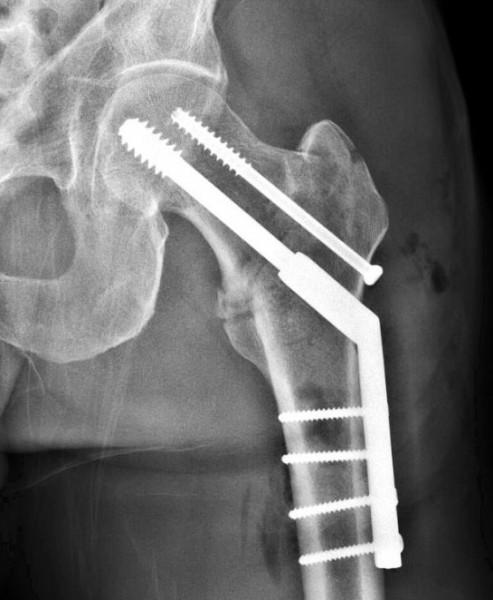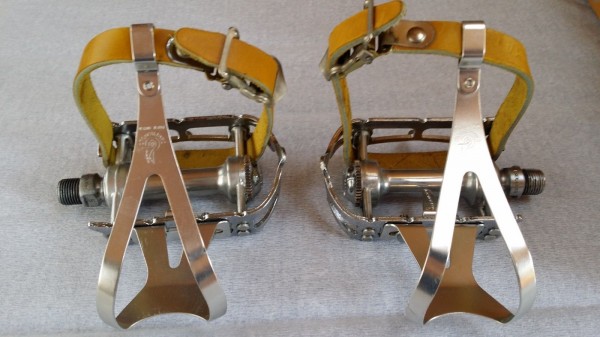I’ve been thinking a bit about breaking my hip from falling at 12 mph in a wet corner. I honestly didn’t think it was possible for that to happen. I’ve fallen on my hips more times than I’d like to think about and nearly every one of those other times I was going more than twice, to three times, as fast.
Honestly, I think the lack of speed and abruptness of the fall was the reason it broke. It’s not like I hit my hip on the road. The bone is way deep in my upper thigh. It is that my lower leg hit the ground and leveraged that force on my bone and it broke above the femur. The speed I hit the pavement, because of the lack of fiction from water, really added to the whole outcome. The same as the first week in the Tour, lots of crashes and broken things because of water.
I used to think that collarbones and separated shoulder were the most common injuries in cycling. After crashing and posting it here, I couldn’t believe how many different people contacted me and sent me x-rays of their breaks. I’m rethinking it now.
One reason that I think more bones are breaking in the sport is because our bikes aren’t connected to us when we hit the ground. When we were securely connected to our bikes, thru toe straps, our bikes took a certain amount of the force. I have lots of recent videos of myself crashing and in everyone, I’ve twisted my feet, trying to avoid the crash, enough, to unclip my pedals. So, my bike get launched away from me before I hit the pave.
You might not think that rubbing your pedal quil on the ground would take that much force, but they did. Also our handlebars. Any force that our bikes absorb hitting the ground is energy that doesn’t go into our bodies, thus it is less likely to get injured as badly.
Anyway, I’m not trading in my clipless pedals for the sake of safety. But, it might take me a while to get comfortable again, taking a left hand corner in the rain.







I would think that the reduction of friction due to the water would help in a crash since you’d be sliding more and dissipating the energy over a longer period of time.
It depends on how you fall. It is just like ice. You laugh when you fall and slide for 50 ft, but if you fall straight down it is the same as hitting pavement. The lack of friction increases the acceleration straight to the ground. My most painful crashes were also at slow speed accelerating towards the ground.
A few months ago I tried going back to the old toe clip pedals for a tour I was going to do. Seemed like I fell once or twice every time I got on the bike. I ended up riding with SPDs and had no problems.
I’ll cast my vote for the newer clipless technology pedals for both road and mountain bike.
Just curious, do you think bone density had anything to do with your break? For a few years bone density issues in cyclists seemed to be what everyone was talking about, but I haven’t heard anything about it in a while.
This VN article is a great example, quoting some scary research showing loss of bone density independent of dietary intake…followed by meal suggestions for increasing the amount of calcium in your diet. Oof.
Sorry, I forgot the link:
http://velonews.competitor.com/2009/10/training-center/nutrition/a-sports-nutritionist-looks-at-the-problem-of-low-bone-density-in-cyclists-and-what-they-can-do-about-it_99433
It is Interesting how you described exactly what caused your femur to break at the trochanter. I broke my femur in the exact same spot three years ago, and the memory of the fall is very fuzzy, but I thought it was because I landed square on my hip on the pavement. Maybe I did the same thing as you – hit in the lower leg first, leveraging upward to the head of the femur.
Glad you are healing correctly. It was about this time in my recovery when I realized I was screwed – they put the femur back together wrong, my leg was shorter by 3/4″, and it took two surgeries and 18 months to get back to normal.
…and didn’t twist the strap as it went through the pedal body to keep it from migrating.
Stevie, you’re also 20-25 years older than you were when you last fell in toe clips and straps. John is spot-on. Everyone’s bone density diminishes as they age; low-impact endurance athletes (swimmers, cyclists) suffer even more rapid loss of bone density. Low-speed falls by the 50+ cycling contingent results in an amazingly high incidence of fractured “hips” (femurs). Weight training and plyometrics can mitigate this somewhat, as can calcium supplementation, but basically, dude, you — like all of us — are living proof of the phenomenon known as entropy . . .
The pros are using diets that involve bicarbonate and messing with their ph to lose weight from bone density. That’s my guess. Take Wiggins for example. 6’3″, 180lbs when he was having success early in his career with TT’s etc. Supposedly 150lbs when he won the tour. A orthopedic doc told me 20lbs of Wiggins loss could easily be from bone density loss. 170lbs is probably Wiggins extreme lowest safe body weight.
Wow. That’s insane.
Not as clumsy or random as a clipless pedal; a more elegant pedal for a more civilized age.
Don’t forget to route the strap around the outside of the pedal cage so it doesn’t pinch your foot as much. I’ll show how after I lace up my Adidas Eddy Merckx Super’s
Looks to me like the straps are run in the proper direction. The pedals are horizontally rotated 180 degrees. The tab on the rear portion of the cage is to keep the strap away from the crank arm. I preferred (up until 1996) to run the straps out the back of the pedals. Twisted of course.
I suppose they would work run either way, the way they are you would push down on strap to tighten. Those strait leather ones would squeeze like a rubber band. Binda extras were best-very little stretch.
Yeah-Obviously bone density and strength has a lot to do with whether you fracture something in a fall or not. That being said, I have a ton of pictures from guys in the upper 20’s and 30’s who did the exact same thing as me.
I have to assume I’m more fragile than I was younger. But, my doctor, a trauma surgeon at the University of Iowa, said that my bone was super hard when he drilled into it. Said something like I must of fallen pretty hard to break it. I doubt he just said it to make me feel better, but there is always that chance I guess.
I think my bike going out from under me so quickly and me hitting the bricks at not a slight angle, like it would be if I were going faster, but acutely, made a huge difference. Plus, the bricks weren’t super wet, so I sort of stuck when I hit. All these things factor in to the resulting broken hip.
Like I put in my post, I am so surprised about how many broken hips and femurs are out there. There are 3 or 4 more incidences listed on my Facebook page. Weird.
https://www.facebook.com/steve.tilford.73
Back in the day, I would get bad groin pulls from crashes because one foot wouldn’t come out of the toe clip.
Ever since I went clipless, with the old PP76, I cranked down the tension all the way, so that I wouldn’t unclip until The impact of the crash, jarred them loose.
.
.
Did you not read the original comment? “Bone density is independent of dietary intake”. Research. You cannot change bone density by changing your diet. You can only starve yourself so much before you lose power due to muscle degradation. I’m sure Wiggins found that weight, and used it to win his tour. Targeting bone density as a weight loss strategy sounds like a load of crap. Don’t believe everything you read on the internet.
I have no doubt your bone density is up to par due to the running and impact workout you get from cyclocross 6 months a year. Keep on keepin’ on dude.